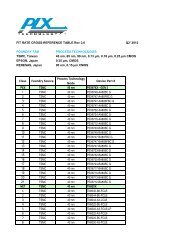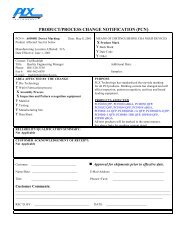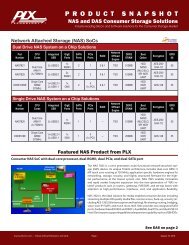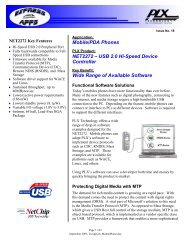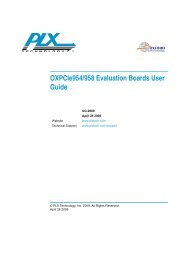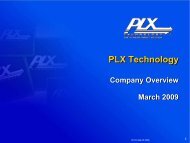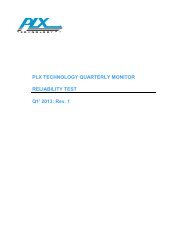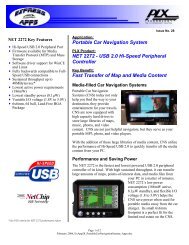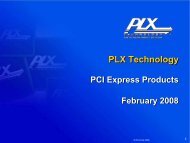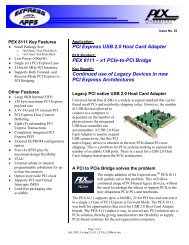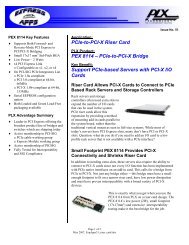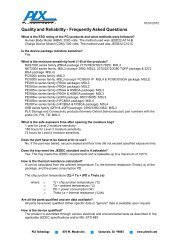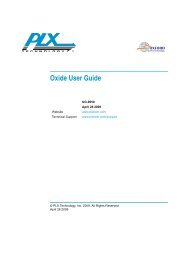the 2009 Annual Report (pdf) - PLX Technology
the 2009 Annual Report (pdf) - PLX Technology
the 2009 Annual Report (pdf) - PLX Technology
You also want an ePaper? Increase the reach of your titles
YUMPU automatically turns print PDFs into web optimized ePapers that Google loves.
Amortization of purchased intangible assets decreased by $0.5 million or 42.0% in <strong>the</strong> year ended December 31,<br />
2008 compared to 2007. The decrease was due to customer base acquired as a result of <strong>the</strong> NetChip <strong>Technology</strong>, Inc.<br />
acquisition in May 2004 becoming fully amortized in 2007 and <strong>the</strong> developed core technology acquired as a result of<br />
<strong>the</strong> HiNT Corporation acquisition in May 2003 becoming fully amortized in May 2008.<br />
Impairment of Goodwill, O<strong>the</strong>r Intangible Assets and Long-Lived Assets. During <strong>the</strong> fourth quarter of 2008, we<br />
assessed goodwill and long lived assets for impairment as we observed that <strong>the</strong>re were indicators of impairment. The<br />
notable indicators were a sustained decline in our market capitalization below book value, depressed market<br />
conditions, deteriorating industry trends and a significant downward revision of our forecasts. These market<br />
conditions continuously change and it is difficult to project how long an economic downturn may last. Our goodwill<br />
and intangible assets were primarily established in purchase accounting at <strong>the</strong> completion of <strong>the</strong> Sebring, HiNT<br />
Corporation and NetChip <strong>Technology</strong>, Inc acquisitions in 2000, 2003 and 2004, respectively.<br />
The projected discounted cash flows for our single reporting unit were based on discrete five-year financial<br />
forecasts developed by management for planning purposes. Cash flows beyond <strong>the</strong> discrete forecasts were estimated<br />
using terminal value calculations. The terminal value represents <strong>the</strong> value of our single reporting unit at <strong>the</strong> end of <strong>the</strong><br />
discrete forecast period. These forecasts represent <strong>the</strong> best estimate that our management had at <strong>the</strong> time and were<br />
believed to be reasonable. The annual sales growth rates ranged from 5% to 7% during <strong>the</strong> discrete forecast period<br />
and <strong>the</strong> future cash flows and terminal value were discounted to present value using a discount rate of 22%. The<br />
terminal value was based on <strong>the</strong> application of an 8.0x multiple to forecasted 2013 earnings before interest, taxes,<br />
depreciation and amortization expense (EBITDA). The discount rate was based on an analysis of <strong>the</strong> weighted<br />
average cost of capital of our single reporting unit. The EBITDA multiple used in <strong>the</strong> terminal value calculation was<br />
based upon EBITDA multiples paid in comparative merger and acquisition transactions and a review of trading<br />
multiples for similar public companies and considered <strong>the</strong> growth prospects and profitability for our single reporting<br />
unit at <strong>the</strong> end of <strong>the</strong> discrete forecast period.<br />
Prior to our goodwill impairment testing, we also assessed <strong>the</strong> fair value of our long-lived assets, including our<br />
corporate headquarters building and amortizable intangible assets. For <strong>the</strong> corporate headquarters building, we used<br />
<strong>the</strong> sales comparison approach and <strong>the</strong> income capitalization approach, each equally weighted, to arrive at a fair value<br />
estimate. We determined that <strong>the</strong> carrying value of <strong>the</strong> property was not recoverable and exceeded its fair value, and<br />
we recorded an impairment charge of $18.8 million. For <strong>the</strong> amortizable intangible assets, which included acquired<br />
technology, we estimated a negligible fair value using a relief from royalty method and recorded an impairment<br />
charge of $0.8 million related to all of <strong>the</strong> remaining net book value of this acquired technology.<br />
As part of <strong>the</strong> goodwill impairment test for <strong>the</strong> fourth quarter of 2008, we determined that step two of <strong>the</strong><br />
impairment analysis was required because <strong>the</strong> estimated carrying value of our net assets, subsequent to <strong>the</strong><br />
impairment of long-lived assets noted above, exceeded its estimated fair value. The second step of <strong>the</strong> goodwill<br />
impairment test compared <strong>the</strong> implied fair value of <strong>the</strong> goodwill with <strong>the</strong> carrying amount of that goodwill. When <strong>the</strong><br />
carrying amount of <strong>the</strong> goodwill exceeds <strong>the</strong> implied fair value of that goodwill, an impairment loss is recognized in<br />
an amount equal to that excess. The implied fair value of goodwill is determined in <strong>the</strong> same manner as <strong>the</strong> amount of<br />
goodwill recognized in a business combination. The determination of <strong>the</strong> amount of <strong>the</strong> impairment required that <strong>the</strong><br />
fair values of our assets and liabilities be determined as if <strong>the</strong> Company had been acquired in a hypo<strong>the</strong>tical business<br />
combination with a purchase price equal to <strong>the</strong> fair value of <strong>the</strong> reporting unit as of December 31, 2008. As a result<br />
of this analysis, we recorded an impairment charge of $34.7 million related to all of <strong>the</strong> recorded goodwill.<br />
In <strong>the</strong> fourth quarter of <strong>2009</strong>, we tested <strong>the</strong> goodwill acquired in <strong>the</strong> Oxford acquisition in January <strong>2009</strong> and<br />
determined <strong>the</strong>re was no impairment.<br />
27




